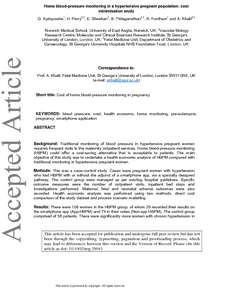Xydopoulos, G; Perry, H; Sheehan, E; Thilaganathan, B; Fordham, R; Khalil, A
(2019)
Home blood‐pressure monitoring in a hypertensive pregnant population: cost‐minimization study.
Ultrasound Obstet Gynecol, 53 (4).
pp. 496-502.
ISSN 1469-0705
https://doi.org/10.1002/uog.19041
SGUL Authors: Khalil, Asma
![[img]](https://openaccess.sgul.ac.uk/109676/1.hassmallThumbnailVersion/Xydopoulos_et_al-2018-Ultrasound_in_Obstetrics_%2526_Gynecology.pdf)  Preview |
|
PDF
Accepted Version
Available under License ["licenses_description_publisher" not defined].
Download (1MB)
| Preview
|
Abstract
Objective
Traditional blood‐pressure monitoring in hypertensive pregnant women requires frequent visits to the maternity outpatient services. Home blood‐pressure monitoring (HBPM) could offer a cost‐saving alternative that is acceptable to patients. The aim of this study was to undertake a health economic analysis of HBPM compared with traditional monitoring in hypertensive pregnant women.
Methods
This was a cost‐minimization study of hypertensive pregnant women who had HBPM with or without the adjunct of a smartphone application (App), via a specially designed pathway, and a control group managed according to the local protocol of regular hospital visits for blood‐pressure monitoring. Outcome measures were the number of outpatient visits, inpatient bed stays and investigations performed. Maternal, fetal and neonatal adverse outcomes were also recorded. Health economic analysis was performed using direct cost comparison of the study dataset and process scenario modeling.
Results
The HBPM group included 108 women, of whom 29 recorded their results on the smartphone App and 79 in their notes. The control group comprised 58 patients. There were significantly more women with chronic hypertension in the HBPM group than in the control group (49.1% vs 25.9%, P = 0.004). The HBPM group had significantly longer duration of monitoring (9 weeks vs 5 weeks, P = 0.004) and started monitoring at an earlier gestational age (30.0 weeks vs 33.6 weeks, P = 0.001) compared with the control group. Despite these differences, the mean saving per week for each patient using HBPM compared with traditional monitoring was £200.69, while for each HBPM patient using the smartphone App, the weekly saving was £286.53 compared with the control group. The process modeling method predicted weekly savings of between £98.32 and £245.80 per patient using HBPM compared with traditional monitoring.
Conclusion
HBPM in hypertensive pregnancy appears to be cost saving compared with traditional monitoring, without compromising maternal, fetal or neonatal safety. Larger studies are required to confirm these findings.
| Item Type: |
Article
|
| Additional Information: |
This is the peer reviewed version of the following article: Xydopoulos, G. , Perry, H. , Sheehan, E. , Thilaganathan, B. , Fordham, R. and Khalil, A. (2019), Home blood‐pressure monitoring in a hypertensive pregnant population: cost‐minimization study. Ultrasound Obstet Gynecol, 53: 496-502, which has been published in final form at https://doi.org/10.1002/uog.19041. This article may be used for non-commercial purposes in accordance with Wiley Terms and Conditions for Self-Archiving. |
| Keywords: |
blood pressure, cost, health economic, home monitoring, pre-eclampsia, pregnancy, smartphone application, Obstetrics & Reproductive Medicine, 1114 Paediatrics And Reproductive Medicine |
| SGUL Research Institute / Research Centre: |
Academic Structure > Molecular and Clinical Sciences Research Institute (MCS) |
| Journal or Publication Title: |
Ultrasound Obstet Gynecol |
| ISSN: |
1469-0705 |
| Language: |
eng |
| Dates: |
| Date | Event |
|---|
| 2 April 2019 | Published | | 12 March 2019 | Published Online | | 3 March 2018 | Accepted |
|
| Publisher License: |
Publisher's own licence |
| Projects: |
|
| PubMed ID: |
29516615 |
 |
Go to PubMed abstract |
| URI: |
https://openaccess.sgul.ac.uk/id/eprint/109676 |
| Publisher's version: |
https://doi.org/10.1002/uog.19041 |
Statistics
Item downloaded times since 22 Mar 2018.
Actions (login required)
 |
Edit Item |



